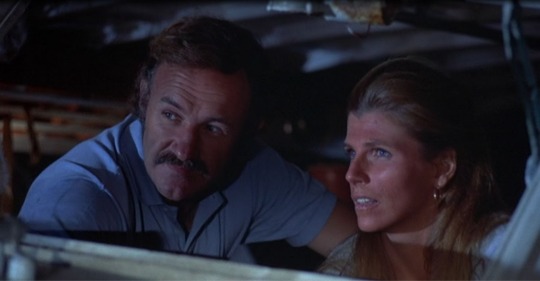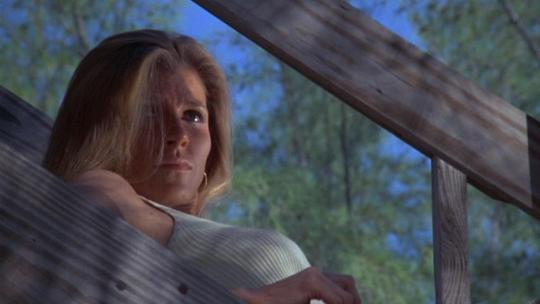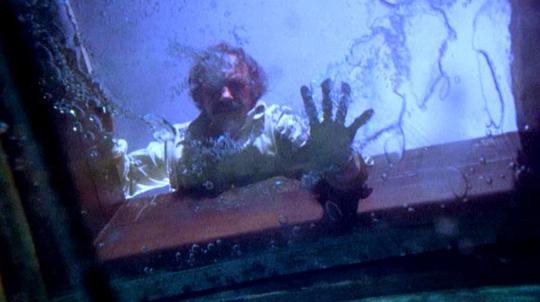Every Man Is an Island: Perspective and Noir in "Night Moves" by Daniel Carlson
By Yasmina Tawil

“It was a time for a certain kind of consciousness, which I’m calling American: a recognition that the world is more complex than what it was believed to be and that there are things that just cannot be solved.” — Alan Sharp
In 1973, nothing was the way it was supposed to be. The postwar boom had given way to civil strife; wars — military, cultural, familial — no longer had clear sides or winners. It was the first blast of the oil crisis and the start of the Watergate hearings. Dr. King and Bobby Kennedy had been gunned down only five years earlier, and Medgar Evers and JFK had been murdered just five years before that. The world was brown and muddy and unforgiving, and stagnation ran through everything like a stench that resisted laundering. It was one thing to consider the possibility that everyone has to lose once in a while; it was another to consider that there might never be a way to win. The art of the era wrestled with this newfound identity crisis, exploring the notion of an America where the good guys don’t come out ahead, and more, in which they don’t even score a moral victory or learn a cold-comfort lesson about the grace of defeat. Some of the biggest films from that period are all about the inevitability of loss and the curdling of innocence into something sour and hard: 1971’s The French Connection and The Last Picture Show, 1972’s The Godfather and Deliverance, 1973’s The Exorcist and The Long Goodbye. It was an era of getting knocked off the horse and, rather than returning to the saddle, questioning the point of riding in the first place. All of this was in the atmosphere that gave birth to the stellar neo-noir Night Moves.
Shot in 1973 and released two years later, Night Moves started as a script by Alan Sharp, a Scot who churned out a batch of Western screenplays including The Hired Hand and Ulzana’s Raid. The original title, per Sharp, was An End to Wishing, and it was also known for a while as The Dark Tower before the final title was chosen. Sharp wanted to write something rooted in a genre he could deconstruct, subverting an audience’s expectations while also mourning the state of the modern world. The private eye film, enjoying a revival, was the perfect vehicle for this kind of experimentation. Instead of busting the bad guys and getting the girl, Sharp’s anti-hero could lose everything; instead of cracking the mystery, he could remain frustrated by his inability to solve it; instead of winning, he’d realize he was never in the game. The script is resolutely focused on failure and laced with barbs that reflect the down sentiments of the time. When one character asks, “Where were you when Kennedy got shot?”, another responds, “Which Kennedy?” Or there’s the moment when a woman asks her husband which team is winning the football game he’s watching, only for him to reply, slumped in his chair, “Nobody. One side’s just losing slower than the other.” The film can be classified as a mystery, but it’s more of an existential meditation on the impossibility of ever knowing anything for certain, even when the facts are right in front of you.
The bones of the story are classic genre stuff: a P.I. is hired to track down a missing girl. The investigator is Harry Moseby (Gene Hackman), a former pro football player who’s traded in his Oakland Raider jersey for days in a grubby L.A. office and nights spent chasing deadbeats and divorce cases. Moseby is hired by Arlene Iverson (Janet Ward) to find her daughter, Delilah “Delly” Grastner (Melanie Griffith). Arlene is a faded star from Hollywood’s classic era, and both of her marriages were within the entertainment industry: her first husband was a producer fond of biblical epics, the inspiration for their daughter’s name, while her second husband, Tom Iverson (John Crawford), was a pilot and stuntman who’s since relocated to the Florida Keys. Moseby’s directive is simple — find the girl — and it is the one and only thing he’ll understand clearly. His path to Delly eventually leads him to Tom’s place in Florida, where Moseby finds the girl ensconced in a dicey relationship with her stepfather, and where Moseby meets Paula (Jennifer Warren), whose relationship to Tom is murkily defined. One night, Moseby, Paula, and Delly take a boat offshore to do a little swimming, and they come across the wreck of a small plane, with the dead pilot still strapped into the cockpit. The identity of this pilot, the deeds that put him underwater, and his relationship to Paula and Tom are what set the larger plot into motion.
Yet the drive of Night Moves is not that of a man solving a mystery, or even of a man solving a mystery while suffering some degree of loss, but rather, an exploration of the hero’s fundamental inability to solve anything, period. There are no deathbed confessions from suspected killers wherein we learn who was really at the bottom of all the trouble, nor are there any moments of insight for the detective where he suddenly sees how everything fits together. Rather, the script is resolutely focused on Moseby’s inability to get beyond his own perspective. He’s too aloof with his wife to see that he’s losing her to another man; he’s too collegial with the people he investigates to question their motives; he’s too committed to his own theory of what’s going on to see the truth right in front of his nose. It’s a statement born of the times and crafted in response to America’s great lumbering self-destruction, as it slaughtered its black citizens in the streets and imposed its will in a civil war on the other side of the world. Moseby’s problem comes from within, and by definition, he won’t be able to see it.
“He had to be reduced to realizing that there really wasn’t any case to be solved — the ‘case’ was an invention of his, and even if there was a case to be solved, he was not going to solve it.” — Sharp
Sharp’s material found the ideal match in director Arthur Penn. Although Sharp said afterward that “Arthur really didn’t want to make a downer movie” in which “everybody got the shit kicked out of them,” Penn was primed for such a journey. He spoke in 1976 about going through a three-year depressive period after his successes with Bonnie and Clyde and Little Big Man, during which he didn’t make any features. “I just gave up on things,” he said then. “I lost myself. For three years I stopped doing what really made me happy and what I really wanted to do.” Expanding on that in a 1990 interview, he said that Night Moves was such a dark film because it came about “during a time of great despair”: “I’d been one of the people advising Jack’s staff on techniques to be used on the debates with Nixon, and I was literally with Bobby just before he went to California because we were starting to do some commercials. When they were killed, the bottom just sort of dropped out. I was looking for a film to deal with this despairing aspect, the loss of confidence and optimism that I associate with the American temperament.” He picked up The Dark Tower almost on a whim, willing himself back into the world and using the film to battle whatever devils he could find.
Yet beyond just being an emotional fit for the material, he’s an aesthetic one, too. Night Moves is about the way Moseby’s actions and inherent flaws wind up clouding his investigation beyond his ability to notice, but to successfully depict that on film — to actually take the viewer on the same journey as Moseby, and to drive home the desperation and confusion of the story’s tangled connections — Penn has to operate with restraint and focus. There can’t be any of those lingering shots on someone’s face you get in so many other mysteries, in which a character you’d previously assumed was innocent suddenly stops smiling and looks hauntingly at the protagonist, who’s not even paying attention; those looks are the staple of a certain kind of mystery film and television that wants to keep the viewer hooked by flattering them that they might know more than the detective. Moments like that are where filmmakers tip their hand, and there are none to be found in Night Moves. Similarly, when Moseby generates a hypothesis about who’s behind a killing related to his pursuit of Delly, Penn doesn’t do anything to cinematically reinforce the notion that Moseby’s right or wrong. There’s no sense of relief cued by music or editing, nor is there a sense of worry created by mania or doubt in Hackman’s performance. Penn refuses to hold anyone’s hand here, opting (rather bravely) to allow the story to unfold of its own momentum. Penn’s masterful execution and occasional enhancement of Sharp’s screenplay is beautifully tight, keeping the viewer locked into Moseby’s clouded perspective, forcing us to live in a feeling of vague unease as we struggle, like Moseby, to sort up from down.

If Sharp and Penn are two legs of the stool, then Hackman is the third. Hackman is one of the best actors who’s ever walked in front of a camera, and his performance here is both subtle and fantastic. He’d been working in film since the early 1960s, and by this point he’d broken through to bigger roles, including in two films that would come to stand as New Hollywood classics: 1967’s Bonnie and Clyde, also directed by Penn, and 1971’s The French Connection. He brought a shopworn heft to his performances, standing 6’2” and moving with a rangy swagger, quick to smile but just as quick to reveal that smile as somewhat dishonest, more a defense mechanism meant to defuse tension than a reflection of any real feeling. He’s able to do more with a few glances or shrugs than others could with pages of soliloquy. Part of what makes his work here so affecting is the way he expresses Moseby’s repeated struggle to see the bigger picture. Sometimes this takes the form of confessions to lovers, while other times it comes across in his sudden fierce latching to a new hypothesis. Moseby doesn’t act like he has it all figured out, but like he has the ability to get it all figured out. It’s hubris, and Hackman has the strength to look foolish. Without his commitment, Moseby would be forgettable, but with it, we get a portrait of a sad man too arrogant to realize his fate’s already been sealed.
There are many wonderful moments between Hackman and the camera in Night Moves, though two stand out as particularly powerful. The first is what’s played as an obvious metaphor for Moseby’s professional impotence. In it, Moseby’s down in the Keys, having located Delly and struck up a relationship with Paula, and he’s fiddling with his portable chess set on the porch of the cottage he’s using on Tom’s small compound. He’s recreating an old match from the 1920s in which a skilled player was put into checkmate with three small moves (and they were, yes, knight moves). Paula says the check sequence is a beauty, and Moseby replies, “But he didn’t see it. He played something else and lost. He must’ve regretted every day of his life. I know I would have. Fact is, I do regret it, and I wasn’t even born.” It would be so easy for any actor, even a good one with a good director, to lean too hard on this, as if the character’s read the script and knows what will happen. But Hackman’s got way too much skill for that. He underplays it, wistful at the imagined memory, making the line reading believable. Then there’s the scene with Moseby and his wife, Ellen (Susan Clark), as they lie in bed and he tells her about the time he tracked down his estranged father. His earlier version of the story to her, in which he and his father spent a week together and cleared the air, had been a lie. In truth, Moseby had tracked his father to Baltimore and started to approach him in a park, only to stop a few feet away and turn around. Telling this story, working to get the truth out, Hackman actually covers his face with his hands, and Clark has to pull them away. The look on his face when he’s unmasked is almost impossible to describe: ashamed, relieved, confused. “To stand six feet away from your own father and then walk away,” he says. “I should’ve jumped. Trouble is after the first six feet it’s kind of hard to tell whether you’re jumping or falling.” His vulnerability is almost startling. More than that, though, it’s a chance for Moseby’s tragic flaw to display itself: he was too close to the situation to know what to do. It stopped him from taking action with his father, and it’s what will stop him from understanding what’s happening with Tom Iverson, Paula, and the mysteries off the Keys.

“I never actually thought the film was a particularly viable prospect, commercially.” — Sharp
Night Moves is a beautiful and rewarding film, in the sense that it pays dividends when you revisit it and are able to see all the things Harry Moseby’s doomed to miss. His hunt leads him to an ending trapped in stasis, no closer to resolution or satisfaction than when he began. There’s actually an echo of the film’s haunting, perfect ending in another Hackman film, The Conversation, which wound up beating Night Moves to theaters by a year. (Night Moves was produced at the tail end of a writers’ strike, and Penn expressed regret later that he didn’t have more time to rework the script before shooting.) The film wasn’t a success upon release, which didn’t surprise Sharp, who figured it wouldn’t be suited for mass audiences anyway and who also noted that the film’s $4 million cost could’ve been considerably lower. For his part, Penn would go on to lament that “the public wasn’t ready for a film that challenged the sacred laws of genre at a time when most films were slavishly following conventions. We were a few years too late. In 1973, in the midst of the Watergate scandal, people wanted to see traditional heroes. Anti-thrillers weren’t in fashion.” There’s some truth to that — movies like Night Moves are always hard to put over — but it also feels a little inaccurate. Night Moves came out the same year as One Flew Over the Cuckoo’s Nest and Dog Day Afternoon, which were, respectively, the third- and fourth-highest grossers of the year in the United States. People were plenty willing to watch movies without traditional heroes and that bucked conventional storytelling. No, if anything, it’s that Night Moves is just a grim, quiet, almost literary film, the kind destined to build an audience gradually, and it had the colossal misfortune of hitting theaters nine days before Jaws.
Only fools, of course, equate box office success with artistic quality. Night Moves may have been swallowed up on release, but it’s as powerful today as it was forty years ago, vibrant with the energy of an uncertain time. There are almost no establishing shots, and Penn’s fondness of letting sound and dialogue from one scene bleed into the next gives it a sinking, storm-tossed feeling. It’s a film haunted and defined by waters, fighting against a tide, and it refuses to find easy solutions — or any solutions — to the way two people can suddenly find themselves driven apart by differing perspectives. More than one home in the film has a decorative adhesive prism attached to its window, allowing someone to look out and see the same objects simultaneously close and farther away, both properly preserved and convexly skewed. Everything here is about lenses, views, and fractured angles. It’s a film designed to wash over you, letting you try again and again to get close to its heart, only to inevitably be blindsided. It’s no accident that some of the film’s biggest moments of discovery — Moseby finding the pilot, and Moseby’s own bitter end — take place on a glass-bottom boat, a vehicle that provides a window to another world that’s inevitably altered and refracted. The boat’s name? The Point of View. I didn’t even notice it the first time.


